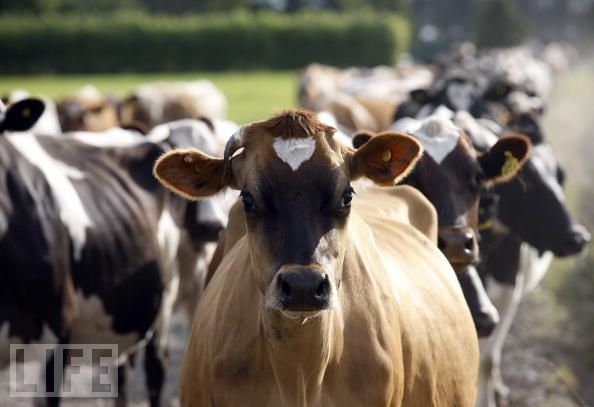
This is an interesting article comparing NZ's and the Australian dairy industry with land values and dairy debt. Land values are considerably cheaper over the ditch and stiff competition for milk volumes means farmers do not have to buy shares in the company they supply, and the resulting debt is 3 times as low.
Olam International was reporting that Open Country Cheese would most likely to report a loss this year because of high milk prices, and suggests the system of setting milk prices is unviable. The government is under pressure to reduce the price of milk through an independent milk pricing structure, that would set the price independent of Fonterra.
All this points to pressure on the milk payouts in the next few years, and earlier comments by Fonterra of a reduced payout next year adds fuel to this.This then puts pressure on those 15% of dairy farmers that are financed with debt $35/kg ms and above, who would struggle to be profitable with a payout under $6/kgms. And with farm costs rising, especially for big inputs like farm labour, fertiliser and fuel costs, keeping farm working expenses and drawings under control will be a challenge.
The farm lending sectors exposure to dairy debt, made them and the Reserve Bank nervous, and since their escape because of strong commodity prices, they have taken a more cautious approach that has been reflected in the real estate sales. The heavily indebted are not out of the woods yet, and the Commerce Commissions report at the end of the month , and future dairy commodity prices will need to be watched very carefully by those 15%.
The debt carried by the average New Zealand dairy farm has increased four-fold in the past 10 years, with the average production farmer now in hock to the bank for $2.8 million reports The Sunday Star Times. However, annual milk production has increased by 60% in that period from 80,000kg milksolids to 129,000kg ms, said the senior economist at industry body DairyNZ, Matthew Newman.
The average debt level equates to $21.65kg ms. In contrast, an average Australian dairy farmer's debt is three times lower at $A7.50kg ms. Continuing high farm debt, particularly in dairying, was highlighted again last week by the Reserve Bank in its latest health check of the economy, the Financial Stability Report. Governor Alan Bollard said banks which had over-stretched themselves while lending to the rural sector had been "very lucky" dairy prices rebounded in the past 18 months.
High dairy debt has also been ammunition for industry critics of dairy giant Fonterra's current ability to be the sole setter of the national milk price.They are calling for an independent commission to be appointed and have persuaded the Commerce Commission to have a look at whether a full milk-price inquiry is warranted. The competition watchdog's report is due out by the end of next month.
In a letter to Finance Minister Bill English, an industry player questioned why New Zealand's on-farm debt rose by $30 billion from under $10b in 2000 to nearly $40b in 2009, when Australian on-farm debt only rose from $A3b to $A4.9b in the same period. "They each had the same four big lenders, experienced the same level of global credit expansion, they each saw the same international price signals, commodity price rises/cycles in international markets," the letter said.
"Their size is not too different. New Zealand produces around 16 billion litres [of milk a year], Australia 11 billion. The reason for the big debt difference is that Australia has a highly competitive dairy industry and a "genuine" raw milk/farm gate milk market, the letter said. Australia has at least five dairy companies which buy farmers' milk, including Fonterra. In New Zealand, Fonterra collects and processes 90% of all milk production.
DairyNZ's Newman said reasons for the big debt level difference include a disparity in land values, different payouts for milk and the fact that many Australian farmers do not have to buy shares in the company they supply. However, Australian farmers without shares would not get the dividends Fonterra farmers receive, Newman noted. In 2009-2010, the average price of a hectare of New Zealand dairy land was $32,000 while in Australia's dairying capital, Victoria, it was $A12,000ha, he said.
Newman agreed that dairy debt was high as a result of high commodity prices being capitalised into land values in the dairy boom years before the global financial crisis. "The saviour has been high payouts. If it [payout] dips below $6, a lot will struggle to meet their cash payments," he said.While the average dairy farm debt is $21.65, 15% of farmers have $35/kg in liabilities, he said. "It's a small percentage but very high debt. If you take an average interest rate of 7% and $2.50kg in interest payments, that only leaves $3.50kg for farm working expenses and drawings."
1 Comments
A tad misleading comparing Aussie debt/kg with NZ debt/kg. Doesn't take into account the fact than we employ a pasture based production system that requires land, where as the aussies use higher input systems (bought in grain etc). In short while kiwi farmers are paying more to their bankers, they should (in theory) have lower running costs / kg.
We welcome your comments below. If you are not already registered, please register to comment.
Remember we welcome robust, respectful and insightful debate. We don't welcome abusive or defamatory comments and will de-register those repeatedly making such comments. Our current comment policy is here.